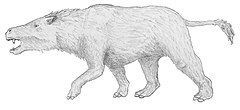Atlantoxenados
| Atlatoxenados Atlantogenata Rango fósil: paleoceno - actualidade | |||||||||||||||
|---|---|---|---|---|---|---|---|---|---|---|---|---|---|---|---|

| |||||||||||||||
| Clasificación científica | |||||||||||||||
| |||||||||||||||
| Superordes e Ordes | |||||||||||||||
| |||||||||||||||

O dos atlantoxenados (Atlantogenata) é un clado, con categoría de magnorde para algúns autores, de mamíferos placentarios definido en 1999 por P. J. Waddell et al.[1]
Este clado comprende as superordes ou cohortes dos Xenarthra, os Afrotheria e o extinto dos Meridiungulata.
O clado orixinouse en África e Suramérica presumibelmente durante o cretáceo.
Xunto ao clado dos Boreoeutheria, conforman os Eutheria. A monofilia deste grupo está apoiada por algunhas probas xenéticas.[1][2]
Porén, hipóteses alternativas suxiren que Boreoeutheria e Afrotheria poden reunirse para formaren Epitheria (criterio apoiado por probas fisiolóxicas, anatómicas e outras), ou que Boreoeutheria e Xenarthra poderían agruparse para formaren Exafroplacentalia ou Notolegia.[3]
Clasificación
[editar | editar a fonte]- Superorde Xenarthra
- Superorde Meridiungulata †
- Orde Pyrotheria
- Orde Astrapotheria
- Orde Notoungulata
- Orde Litopterna
- Superorde Afrotheria
- Orde Afrosoricida
- Orde Macroscelidea
- Orde Tubulidentata
- Orde Hyracoidea
- Orde Proboscidea
- Orde Sirenia
- Orde Embrithopoda †
- Orde Desmostylia †
As diferentes hipóteses
[editar | editar a fonte]| A | B | C |
|---|---|---|
Relacións filoxenéticas
[editar | editar a fonte]| Placentalia |
| ||||||||||||
Notas
[editar | editar a fonte]- ↑ 1,0 1,1 P. J. Waddell, N. Okada & M. Hasegawa (1999): "Towards resolving the interordinal relationships of placental mammals". Systematic Biology 48 (1): 1-5.
- ↑ 2,0 2,1 Murphy, W. J.; Pringle, T. H.; Crider, T. A.; Springer, M. S. & Miller, W. (2007): "Using genomic data to unravel the root of the placental mammal phylogeny". Genome Research 17: 413–421.
- ↑ Wildman, Derek E.; Chen, Caoyi; Erez, Offer; Grossman, Lawrence I.; Goodman, Morris & Romero, Roberto (2006): "Evolution of the mammalian placenta revealed by phylogenetic analysis". Proceedings of the National Academy of Sciences 103 (9): 3203–3208.
Véxase tamén
[editar | editar a fonte]Bibliografía
[editar | editar a fonte]- Nikolaev, Sergey; Montoya-Burgos, Juan I.; Margulies, Elliott H.; NISC Comparative Sequencing Program; Rougemont, Jacques; Nyffeler, Bruno; Antonarakis, Stylianos E. (2007). "Early History of Mammals is Elucidated with the ENCODE Multiple Species Sequencing Data". PLoS Genetics 3 (1): e2. PMC 1761045. PMID 17206863. doi:10.1371/journal.pgen.0030002.
- Springer, Mark S.; Murphy, William J.; Eizirik, Eduardo; O'Brien, Stephen J. (2003). "Placental mammal diversification and the Cretaceous–Tertiary boundary". Proceedings of the National Academy of Sciences 100 (3): 1056–1061. PMC 298725. PMID 12552136. doi:10.1073/pnas.0334222100.
- Waddell, Peter J.; Kishino, Hirohisa; Ota, Rissa (2001). "A phylogenetic foundation for comparative mammalian genomics". Genome Informatics 12: 141–154. PMID 11791233. Arquivado dende o orixinal o 10 de xullo de 2019. Consultado o 26 de setembro de 2015.
- Wildman, Derek E.; Chen, Caoyi; Erez, Offer; Grossman, Lawrence I.; Goodman, Morris; Romero, Roberto (2006). "Evolution of the mammalian placenta revealed by phylogenetic analysis". Proceedings of the National Academy of Sciences 103 (9): 3203–3208. PMC 1413940. PMID 16492730. doi:10.1073/pnas.0511344103.
Outros artigos
[editar | editar a fonte]Ligazóns externas
[editar | editar a fonte]- Clade Atlantogenata Waddell et al. 1999 Arquivado 27 de setembro de 2015 en Wayback Machine. en Fossilworks.
